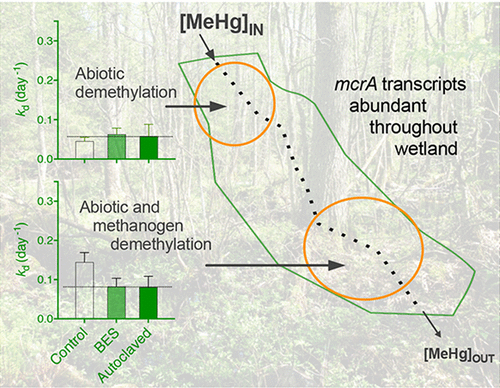Mechanisms of Methyl Mercury Net Degradation in Alder Swamps: The Role of Methanogens and Abiotic Processes
Rose-Marie Kronberg, Jeffra K. Schaefer, Erik Björn, Ulf Skyllberg
文献索引:10.1021/acs.estlett.8b00081
全文:HTML全文
摘要

Wetlands are common net producers of the neurotoxin monomethylmercury (MeHg) and are largely responsible for MeHg bioaccumulation in aquatic food-webs. However, not all wetlands net produce MeHg; notable exceptions are black alder (Alnus glutinosa) swamps, which net degrade MeHg. Here we report the mechanisms of MeHg demethylation in one such swamp (EHT), shown to be a sink for MeHg during four consecutive years. The potential demethylation rate constant (kd) in soil incubations was ∼3 times higher in the downstream (EHT-D: kd ∼ 0.14 d–1) as compared to the upstream part of the swamp (EHT-U: kd ∼ 0.05 d–1). This difference concurred with increased stream and soil pH, and a change in plant community composition. Electron acceptor and inhibitor addition experiments revealed that abiotic demethylation dominated at EHT-U while an additional and equally large contribution from biotic degradation was observed at EHT-D, explaining the increase in MeHg degradation. Biotic demethylation (EHT-D) was primarily due to methanogens, inferred by a decrease in kd to autoclaved levels following selective inhibition of methanogens. Though methanogen-specific transcripts (mcrA) were found throughout the wetland, transcripts clustering with Methanosaetaceae were exclusive to EHT-D, suggesting a possible role for these acetoclastic methanogens in the degradation of MeHg.
|
Modeling Secondary Organic Aerosol Production from Photosens...
2018-04-06 [10.1021/acs.estlett.8b00101] |
|
Reductive Defluorination of Branched Per- and Polyfluoroalky...
2018-04-06 [10.1021/acs.estlett.8b00122] |
|
Kaolin Alleviates Graphene Oxide Toxicity
2018-04-06 [10.1021/acs.estlett.8b00135] |
|
Estimating the Transfer Range of Plasmids Encoding Antimicro...
2018-04-05 [10.1021/acs.estlett.8b00105] |
|
Identification of Chain Scission Products Released to Water ...
2018-04-04 [10.1021/acs.estlett.8b00119] |